Content
The digital transformation of healthcare systems is a positive trend rapidly spreading across numerous healthcare organizations, hospitals, and healthcare facilities. The global aim is to:
- Provide remote 24/7 access to healthcare services
- Streamline repetitive processes
- Reduce healthcare costs
- Improve doctor-patient interaction
- Track and monitor health conditions better
- Minimize medical mistakes
- Make patient care delivery accessible to everyone
However, incorporating technology into complex healthcare systems can be a real challenge for companies investing in web-based healthcare solutions. So, the RewiSoft team will navigate you through all the main intricacies of healthcare web app development so you can be well-prepared to get started.
This article will highlight key features and functionality, tech stack options, regulatory compliances, and other vital things to consider before the development begins. As a bonus from our team, we’ll discuss how to hire a professional healthcare development team to get a rewarding experience and successful release.
Read Also: How to Develop Healthcare Software Product?[ Vendors, Standards, and Real Cases]
We’ll reply within 8 working hours (CET)
What is Healthcare Web Application Development?
According to Statista, the global digital health market will reach 660 billion dollars by 2025. Such a rapidly growing tendency shows that healthcare businesses and digital health investors will invest in digital healthcare projects more.
But what exactly is shaping the digital healthcare market? Here are some facts and statistics from various proven resources.
Up to nowadays, digital healthcare has specific categories such as:
- Mobile health (mHealth) apps
- Electronic health records (EHRs)
- Electronic medical records (EMRs)
- Wearable devices
- Telehealth
- Telemedicine
- Personalized medicine
These rapidly evolving areas of digital healthcare industry are shaping and increasing the market size. Together with the latest innovative tech trends, there is great potential for healthcare investors to achieve progress in any prospective field.
According to Deloitte, digital healthcare uses more than tools and technologies; it also views “radically interoperable data, artificial intelligence (AI), and open, secure platforms as central to the promise of more consumer-focused, prevention-oriented care.” Thus, there are many reasons to believe that the digital health market will gradually change industry-wide standards and improve patient health and quality of care to the greatest extent.
According to Precedence Research, the global digital health market was valued at $270.60 billion in 2021 and is expected to exceed $1,354.68 billion by 2030. This is another proven research that shows the growing market size and rapid technology spread. Why not be an incentive for startups to try their hand at digital healthcare?
So, since numbers and stakes are high in digital healthcare, let’s discuss what healthcare web application development is all about.
Trends that fit well with Healthcare Web Application Development
Let’s analyze which technologies and tools that complement intensive medical web development are improving healthcare delivery.
Artificial intelligence and machine learning
Thanks to AI and ML algorithms, we can create advanced web-based solutions to improve decision-making, enhance medical accuracy and provide personalization. This is highly beneficial for therapists to diagnose patients right and pick a proper treatment. Based on provided symptoms, the system can generate specific issues that can assist doctors in making a final verdict.
IoT
Devices for remote patient monitoring can enhance patient-doctor interaction and ensure a better healthcare experience. For example, IoT health wearables can collect patient health data such as heart rate, blood pressure, and glucose monitoring in real time and enable clinicians to detect vital signs. This information can be visualized and presented on a web-based IoT dashboard integrated with digital patient health monitoring equipment.
Virtual reality
Thanks to technology-led solutions, the quality of medical care improves while minimizing medical mistakes and risks. Virtual environments where clinicians can practice different procedures are great examples of VR applications. VR technology allows doctors to learn to explain symptoms better and more accurately. It is also widely used to facilitate medical training or improve patient mental health.
Blockchain
Blockchain technology applies to healthcare web development when there is a need to perform secure transactions and manage patients’ medical records. The most popular applications of this decentralized technology include:
- Sharing healthcare data
- Keeping electronic healthcare records
- Managing insurance
- Improving the hospital billing process
Read Also: How to Create a Mental Health App in 2023? [Features, Roadmap, Real Cases]
Types of Healthcare Web Application Development
Across a wide range of web solutions for healthcare providers, patients, doctors, and other medical organizations, we divide them into three main categories. Each category includes specific types of web apps.
Medical websites Development
These web solutions are intended to represent useful and easy-to-understand information allowing businesses to build a brand of medical practice or serve as a source of educational materials. For instance,
- Business websites – a web-based solution that can be developed for hospitals, nursing homes, different practices, health networks, etc.
- Catalog websites – display a range of products or services of a medical device manufacturer, pharmaceutical company, healthcare web development company, etc. Explore the development process of a medical catalog website – an online pharmacy website.
- Landing websites – for medical startups
- Health education web sources – for doctors in clinical training, patients, or students who are going to get education on specific materials and gain qualifications
Medical Web Portals Development
There are different medical portals aimed to provide advanced functionality both for educational and healthcare purposes. For instance,
- Patient portals – healthcare organizations develop patient portals to provide patients with 24/7 access to their personal health data, medical advice, appointment scheduling, and assistance
- Medical staff portals – are examples of HR software that is used to share experiences across teams and streamline internal workflows
- Information portals – used as a library that stores medical articles, industry news, information about various diseases and their preventive measures
- Provider portals – represent any important information about healthcare vendors
Web Applications Development
For a wide range of healthcare web applications, we can develop solutions to meet the unique needs of our customers. For instance,
- Healthcare delivery assistance – medical diagnostic apps, clinical decision support apps, e-prescribing software
- Patient data storage and sharing – different hospital information systems
- Patient care and monitoring – telemedicine apps, chronic disease management apps, remote patient monitoring (RPM) apps
- Internal workflow automation – hospital management software, healthcare billing software
Healthcare Web App Development Examples [RewiSoft’s case]
One of our recent projects was dedicated to hospital web app development. CareSync is a hospital management system that optimizes clinic workflows by simplifying doctor-patient interactions, reducing doctors’ workload, and speeding up patient consultations.
On the way to developing a fully-fledged web solution for efficient clinic operation, our team faced such challenges:
- Requirements challenge. By starting to collect and analyze software requirements, at first, it wasn’t easy to describe each app persona and decide what data was enough to perform the main tasks of the clinicians.
- UI design challenge. The next challenge was designing an application layout so it would adapt to any possible screen size.
- UX design challenge. As the core requirements for medical software were the interface simplicity and ease of system navigation, we needed to come up with a logical sign system recognizable by any user.
Solutions to tackle main challenges:
- To solve the requirements challenge, our team conducted thorough research for each app persona to define what data is enough to display for doctors, assistants, receptionists, and admins
- To ensure visual consistency across various displays, we took on designing responsive UI for such common device groups as mobile phones, tablets, desktops, and smart TVs
- We performed several testing cycles to agree on a sign system design accessible to everyone
Features we built:
- Admin dashboard to access, manage and track the locations of doctors, assistants, and patients
- Doctor dashboard with defined task order and priorities for patient consultations in emergency rooms
- Assistant dashboard to make it easier for assistants to view the patient rooms where doctors wait for their medical assistance
- The receptionist dashboard can display the location and workload of doctors and help assistants manage emergencies on time
- Alerts page shows room statuses with customization options
- The sequence page allows admins to build the process of the clinician’s work
As a result, the RewiSoft team developed a fully-functional hospital web solution that aligns with the customer’s expectations and improves the clinic’s services. The new hospital management system is scalable and ready to become an all-in-one web-based solution to meet most clinic and patient needs.
Healthcare Web App Development: Top MVP features from RewiSoft’s experience
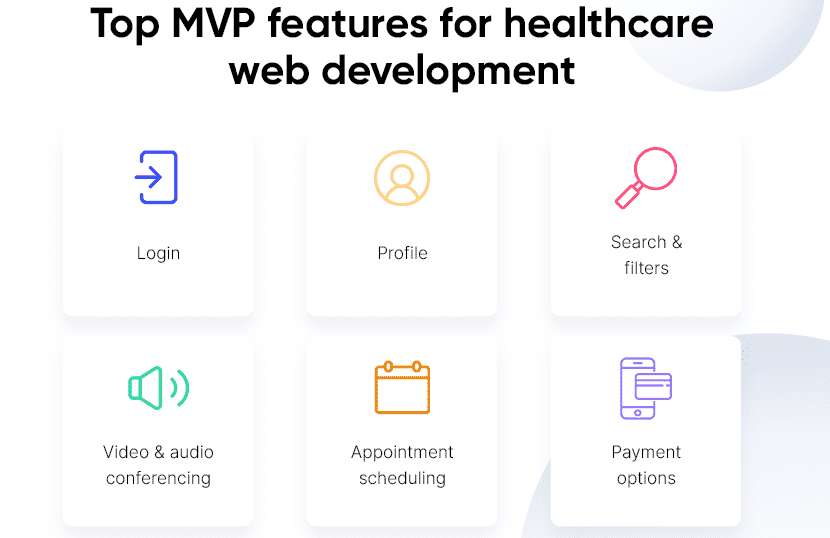

Top MVP features for healthcare web development
Building an MVP is an optimal choice when you:
- Need to validate your idea and analyze honest user feedback
- You lack resources
- You need a fast time to market
However, the list of MVP features depends on your unique project requirements, so the feature list always vary. For our past projects, we also used to develop:
- Task management dashboard
- Doctor’s call
- Patient medical history
- Notifications
- Onboarding
So, when you start a healthcare web app development from scratch, consult with your development team about the MVP features your solution needs. The most common MVP feature set also includes:
Login
Before using a healthcare website, users should log in to the system and create an account. For starters, this can be an easy-to-access login via email or phone number. By the way, we adhere to best design principles and request only relevant data to let users signup in a few moments.
Profile
A user profile is another must-have feature that allows users to fill in personal contact information, add a photo, write a medical history and leave complaints. This feature can also display information about previous visits to doctors.
Search & filters
To make it easier to interact with the app, we are implementing search and filter options to help users search for any information they need, filtered by rating, physician specialization and experience, service type, and more.
Video, audio conferencing & messaging
With the help of mobile devices, users can access high-quality medical services without leaving their homes. Built-in video and audio conferencing permits real-time and smooth communication between doctors and patients.
Read Also: Telemedicine Software Development: Standards, Features, and Cost
In terms of technical implementation, it is required to ensure a highly optimized Internet connection, avoid image distortion and eliminate low sound levels. To meet these requirements, we implement such streaming protocols as
- RTMP (Real-Time Messaging Protocol)
- HLS (HTTP Live Streaming)
- WebRTC (Web Real-Time Communication)
Appointment scheduling
Patients should be able to access the doctor’s calendar and select an available time slot for quick and easy bookings while doctors receive and confirm these appointments.
Payment options
Payment integration is essential for providing simple and convenient payment options for healthcare services. So, any medical web development should include the ability to accept online payments. We can do this through payment gateways like PayPal, Google Pay, Stripe, credit cards, etc.
Advanced Features for Healthcare Web Development


Advanced features for healthcare web development
Depending on your unique case, the professional medical web development provider will consult you on what advanced features your web solution lacks. However, we suggest looking at the below examples we used to develop for our previous projects.
Social login option
Despite standard login via email or phone number, we recommend adding additional registration features via Facebook, Google, Apple, etc., so users can instantly access your web solution. This way, it will enhance user engagement and save them time filling out sign-in forms.
Chatbot integration
To provide 24/7 healthcare service and provide quick support to patients in case of emergencies, our dev team includes chatbot integration into healthcare web development.
Live support
We are sure that online support and consultation increase user retention and positively affect the overall user experience. This way, patients can leave feedback or suggestions for app improvements or ask relevant questions. In turn, you can upgrade and improve your web solution while letting users know that their voices are heard and appreciated and that they also contribute to your platform growth- a win-win scenario.
3D virtual tours
When patients seek hospitals they want to attend, they may often need to view what the hospital looks like before they visit it. One of the best ways to show the hospital’s high-level standing is to provide 3D tour visitings while driving sales and growing the patient base.
Health education
The typical health education web sources that provide health education for patients, doctors, or students willing to get an education or extend professional qualifications will enable users to access different materials online. This way, we can make valuable resources that users can access at any time and find relevant materials.
Gamification elements
Turning the treatment process into an entertaining and interactive game can make the patient experience more positive. Especially for children, when there is a need to encourage them to take medicines regularly and follow the prescribed recommendations. As a result of proper treatment, patients can receive discounts on their following appointments or win free vitamins.
Read Also: How to Build a Gamification Platform in 2023? A Step-by-Step Guide
Medical Web Development: Regulations of the healthcare industry to follow
When it comes to healthcare web app development, we must protect the sensitive data of patients, practitioners, and healthcare providers and comply with regulations stated by local legislation. Let’s briefly detail the most common ones.
HIPAA
A web-based healthcare solution developed for the US market, which processes, records, and stores protected healthcare information (PHI), must strictly adhere to HIPAA regulations. These regulations include privacy and security, enforcement, and breach notification rules. The RewiSoft team has the practical experience and deep-niche expertise in developing HIPAA-compliant web solutions.
CCPA
CCPA regulations are analogous to European GDPR. The law secures new privacy rights for California consumers by:
- Informing them about what data is collected, how it is used and shared
- Preparing reports on the collected data and deleting them upon the client’s request
- Ensuring the right to non-discrimination for exercising their CCPA rights, and more.
GDPR
Another standard that implies high data protection and security protocols implementation is the General Data Protection Regulation (GDPR) to introduce the product in the European Union. The main purpose of the GDPR rules is to protect the customers’ personal data from being collected and used. GDPR applies to both the company that processes data (e.g., cloud storage) and the company that collects it (e.g., social network).
NIST
These regulations represent a collection of standards, tools, and technologies that protect user data of healthcare applications in the United States. Despite requiring significant investment, many organizations consider the NIST frameworks as the best cybersecurity practice to protect the data of users of medical applications in the US.
HITECH
Also valid for healthcare and medical applications running in the United States, HITECH regulations focus more on the EHR systems’ data security.
PIPEDA
The PIPEDA rules apply to applications operating in the Canadian market that store and process personal data. The rules and laws for PIPEDA are similar to those in the GDPR rules that work for the European market.
ISO 13485:2016 standard
This certification specifies requirements for a quality management system for medical devices and related services. ISO 13485 certification ensures that all the requirements for a reliable medical device in the manufacturing and design process are met.
What to consider before moving into medical web development?
Before starting with the development, it’s essential to explore all intricacies of the medical web development process. Below we’d like to highlight the most important factors influencing the success of a final healthcare solution.
Medical data protection
Medical data protection in web-based applications must be thoroughly secured from any data leakage, security breaches, and hacker attacks.
Otherwise, you risk significant financial losses and problems with the law. Healthcare information is considered sensitive data, so the development team must meet compliance requirements like HIPAA or HITECH.
These rules provide guidelines for storing and transmitting electronic patient health information and govern who has access to that data.
Besides this, we implement a solid security system and create robust security architecture to protect the web solution from different threats. The commonly used practices we follow, include:
- End-to-end data encryption
- Multi-factor authentication protection to get to the private user details
- SSL and AES-256 encryption to exchange data over secure HTTP protocol and secure patients’ ePHI
- An expiration policy for a login retry request within a specified time period
Helpful tip: To meet these health industry security standards, the first step is to protect all patient information that your app stores or transfers over the Internet or other computer networks. To ensure the confidentiality and integrity of the transmitted data, provide a secure HTTPS connection for all communications between the application and the server.
Interoperability
Interoperability is the core aspect of healthcare applications responsible for remote health data transmission. So, it’s imperative to ensure real-time and highly-secure interoperability between hardware and software used.
Thus, all consolidated data from various wearable medical devices will be seamlessly transferred to user applications. To ensure seamless and efficient communication between different devices and medical systems, we enable this process through an API.
UX/UI design and responsiveness
The design part of the healthcare web development process requires much attention due to the specifics of the healthcare industry. All medical applications’ UX/UI design should focus on medical features and be precise and responsive.
A medical application should allow users to complete urgent tasks in a clean space quickly. Another essential requirement is app responsiveness, which enables users to access apps or websites on various devices with different screen sizes.
Below, we’ll explain some of the best design practices we follow when designing healthcare web-based solutions.
Accessibility
We recommend providing a design accessible to people with disabilities and accessibility options for users who require additional assistance when using healthcare solutions.
To meet this criterion, we cater to W3C accessibility guidelines that provide information on best accessibility practices to make web content more accessible to people with visual and hearing impairments, cognitive disabilities, etc. Incorporating such practices means adding size-adjustable text, voice readers, HTML tags & captions, color contrast, and similar.
Read Also: Why Should You Outsource to Eastern Europe in 2023? (Price, Pitfalls, and Mistakes)
Healthcare web app development: a Step-by-Step Guide
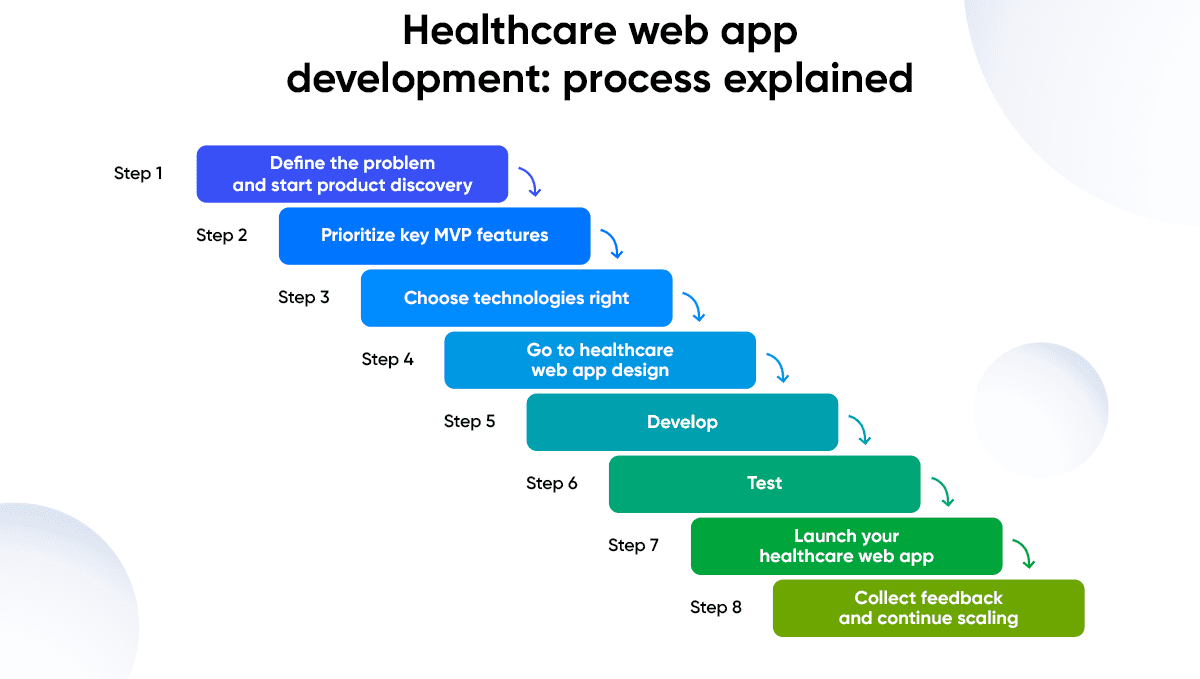

Healthcare web app development: process explained
To fulfill the development process right, meet deadlines, and work within the allocated budget, we start medical web development with a clear project roadmap. Below, we’d like to outline the main healthcare project steps, uncover major nuances and share useful tips.
Step 1. Define the problem and start product discovery
Starting healthcare web development from scratch, it’s essential to analyze the main goals of your platform and define the main problems your solution will solve. For this reason, the RewiSoft team enters the product discovery phase by assigning business analysts to gather web platform requirements, define the scope of the web solution, plan functionality, and estimate costs.
A detailed breakdown of tasks we perform during product discovery:
- Definition and analysis of the target audience. The target audience can be hospitals, doctors, surgeons, or healthcare organizations. The better we understand the core functionality that main customers lack, the more precise functionality we will develop to meet their needs.
- User analysis. We analyze the pain points and define the problems of healthcare platform users to get better insight into future web app functionality and design. We prefer to conduct focus group interviews or surveys to understand the root of user problems and find a simple solution.
- Market and competitor analysis. We perform market analysis to investigate the latest industry trends and analyze direct competitors.
- Planning functionality and creating a preliminary design layout. Our team showcases first app ideas with our customers to be on the same page regarding the future product and overall concept.
- Estimate project time and budget. Many factors influence the final project costs and timelines. Each project is unique, so we can inform our customers more specifically based on the requirements provided.
The output of this phase is a product roadmap covering the completed market research and approved web solution concept.
Step 2. Prioritize key MVP features
Depending on the web application type, we select and prioritize the must-have features for your healthcare web solution.
For example, in the case of the CareSync project, we understood the hospital management platform requires developing separate dashboards for doctors, assistants, receptionists, and admins to visualize different data in one place.
We also implemented geolocation features to help all admins and receptionists understand where doctors and assistants are and assign them to available patient rooms. For the rest of the functions, we chose features that support smooth clinical operation and reduce the workload for each participant in the healthcare process.
We also prefer to add advanced features based on the application goals and users’ requirements, except for crucial MVP features. This can help you scale your MVP solutions to improve platform performance and user experience, grow your business, and generate long-term revenue.
Step 3. Choose technologies right
Choosing the right technologies for healthcare web development largely depends on the application type and core functional requirements. The professional experience of the healthcare web developers you choose to work with also determines the success and quality of your final solution.
The more developers create various software solutions for the healthcare industry, the better they understand the required technologies stack that will be suitable in the particular case.
The choice of specific programming languages, frameworks, and databases should work best and ensure your final web application’s high performance, reliability, and scalability. Otherwise, a poorly chosen technology stack can lead to problems in the future and cost a fortune to rework existing medical applications.
Step 4. Go to healthcare web app design
The healthcare web app design consists of two main parts: user experience and user interface. One of the main requirements for healthcare websites is to make the application easy to understand and navigate for doctors, patients, medical staff, etc., and allow them to find the information they need quickly.
During this step, our UX designers start with a close analysis of user needs to map out a clear user journey and design interactive UX wireframes. Since healthcare web solutions require a specific design, focusing on core medical functionality, accessibility, and responsiveness is the best rule. Once the UX wireframes are ready, our UI designers transform them into clear and engaging interfaces and stick to the best healthcare design principles matching the audience’s traits, health conditions, and roles.
Some of the helpful design practices we follow:
- Ensure consistent and intuitive design by creating clear and simple navigation
- Focus on accessibility for people with disabilities
- Prioritize fewer interaction points as it helps create user-friendly design and provide a better user experience
- Improve product usability in our in-house UX Lab with the UX Eye Tracker, which allows us to explore user behavior while interacting with the product, analyze reading patterns, find gaps, and personalize the experience
- Reduce the cognitive load for users and show all necessary information at the beginning of the user journey since healthcare apps and websites require maximum efficiency and speed of operations
- Make the design responsive to let the app or website run smoothly across different screen sizes and device types, whether it’s a laptop, desktop, tablet, or mobile device
- Create clean design elements and simple graphics
Step 5. Develop
Based on the chosen tech stack, design prototypes, and software requirements specifications (SRS) documentation, the RewiSoft healthcare website developers start implementing the frontend and backend sides of the web-based medical solution. We develop feature by feature to comply with all regulatory requirements (such as HIPAA) and enforce robust security measures to manage user access, encrypt patient data, and more.
Step 6. Test
Testing of medical applications is vital to minimizing risk before a solution goes into production. The RewiSoft team test all features during the medical web development process to mitigate risks timely and avoid project cost overruns during later stages.
However, there are specific tests we execute to check the security, performance, and test platform compatibility with other software and hardware after all features are fully developed. Specifically, we conduct functional, integration, security, and accessibility testing to ensure the solution is fast, secure, and ready for launch.
Step 7. Launch your healthcare web app
Once all the bugs are fixed, your medical web software is ready for use. To launch a healthcare web solution and ensure a smooth integration, we often implement onboarding features and offer training materials for patients, doctors, medical staff, and other users who will use your software.
Step 8. Collect feedback and continue scaling
The healthcare app launch is not the final destination of the healthcare web development process. We appreciate user feedback and often use it for future product updates. After the release, we offer our customers to collect and analyze user feedback, expand functionality, fix bugs, implement improvements and provide ongoing maintenance and support.
Top healthcare web development challenges & solutions by RewiSoft
To make healthcare web development risk-free and efficient, we’d like to address common pitfalls and provide our best practices to help you understand how we avoid them.
Integration with existing architecture
Problem: The healthcare web application should be able to integrate with any existing IT infrastructure or existing services. Integrating a web solution into an IT environment is necessary, especially if it runs in a clinic or hospital.
Solution: Our team can integrate the solutions with existing web portals, web and cloud services, or IoT devices. We implement HL7 integrations with medical software and ensure seamless integration with customer management systems, hospital and patient applications, EHR, CRM, and EMR systems.
Web app scalability
Problem: If your web solution scales in the future, your data volume will increase, and the performance characteristics should be able to withstand this.
Solution: To ensure uninterrupted operation under any traffic load, we create a scalable and highly available architecture to manage high loads and maintain fault tolerance.
APIs
Problem: To connect a healthcare solution to existing infrastructure, healthcare website developers should understand what APIs are needed and how to use them.
Solution: We use APIs to ensure that EHR data is accessible and usable across devices. We prioritize safe and hack-poof APIs to support efficient and smooth interoperability.
How to choose a tech stack for healthcare web development?
A tech stack is a set of technologies used to create web solutions. The choice of tech stack can affect your project time, budget, and final solution quality. So, we prioritize using such technologies and tools that support result-based implementation, time optimization, and cost efficiency during the healthcare web app development:
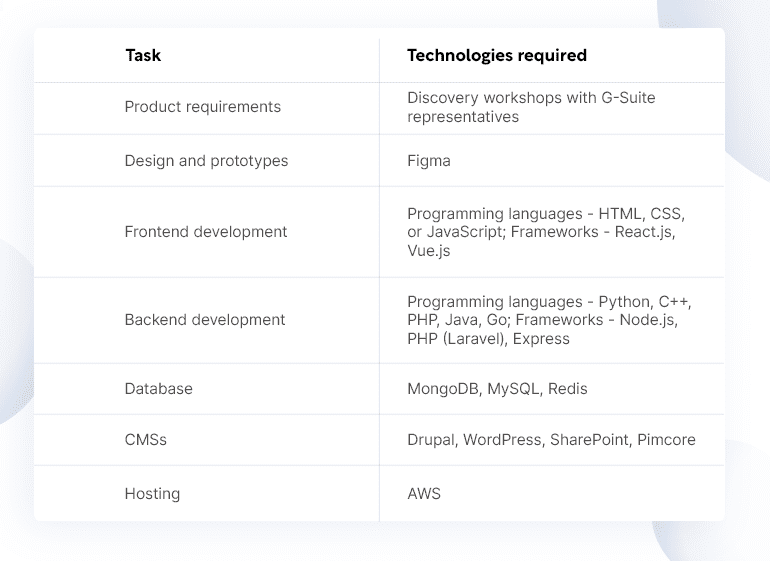

How to choose a tech stack for medical web development?
Depending on the expertise of healthcare web developers, the tech stack may vary. Since stakes are high when building healthcare solutions, we recommend solving all questionable points before going into development and collaborating with a professional team with an industry-relevant portfolio.
How to hire a healthcare web developer?
Hiring a healthcare website developer can be a lengthy process that requires extensive research and certain technical and recruiting skills. Moreover, the team you choose to partner with will directly affect whether you achieve your goals or not and how much effort and time you need. So, let’s briefly outline the pros and cons of the most popular hiring options.
Read Also: Hiring Software Developers in Ukraine: Top 10 Reasons to Consider
Freelancers
Hiring freelancers for healthcare web app development implies searching for specialists across different platforms and websites on your own.
This option can be suitable for small projects.
| Pros | Cons | |
| Freelancers |
|
|
In-house team
Hiring an in-house team implies full-time employment and requires full control and team management from your side.
| Pros | Cons | |
| In-house healthcare web developers |
|
|
Outsourcing agency
Hiring an outsourcing healthcare development agency is suitable for projects of all sizes and business requirements. You can easily find a team to solve your unique problems, develop custom web-based healthcare solutions or upgrade existing platforms.
| Pros | Cons | |
| An outsourcing development agency |
|
|
Dive into more nuances on how to hire an app developer without mistakes and use the best recommendations on successful recruitment and team management from our team!
Read Also: How to Build a Software Development Team in 2023?
Medical Website Development & Design: Cost and Timelines
The medical website design cost depends on the type of web-based solution, complexity, and location of your development team.
At RewiSoft the price starts from $40,000. We divide the development process into four major phases where our clients most often need professional help. In the picture below, you can look at rough costs based on the project stage and team location.
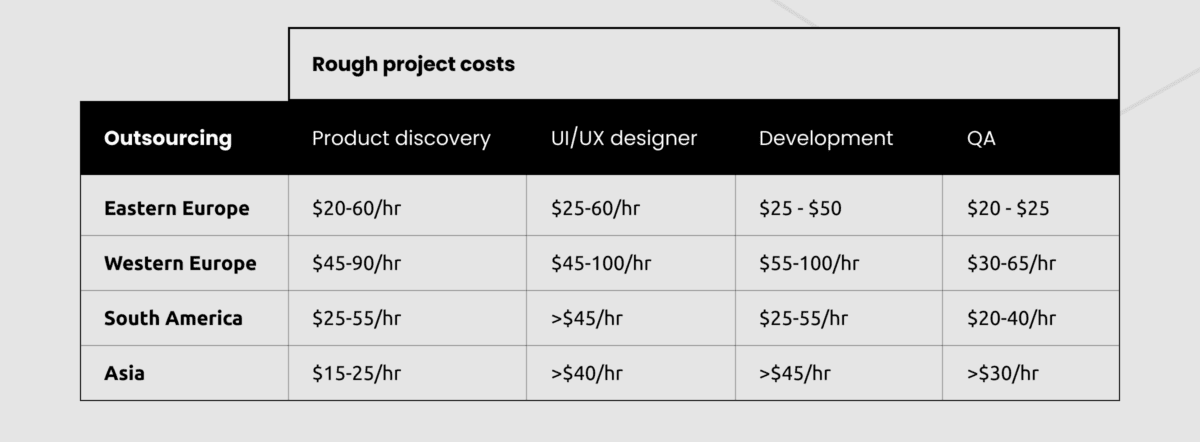

For more information on project timelines, below you can also see RewiSoft’s timeline calculations based on project size and stage.
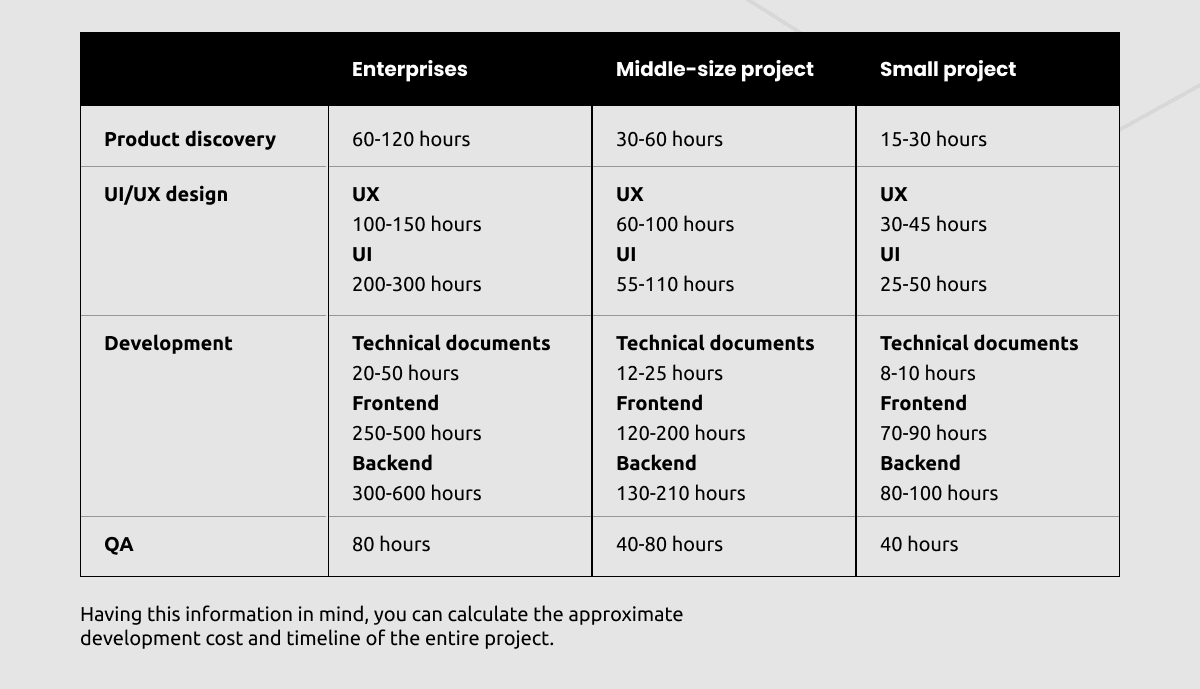

In any case, medical website design cost and project timelines are dependent variables. However, we can inform you more accurately and offer the most optimal solution.
Healthcare Web Application Development: Conclusion
Creating web-based healthcare solutions requires knowledge, relevant experience, and strict adherence to critical technical requirements, as such solutions deal with sensitive health data and help to solve life-matter questions. That’s why, during healthcare web development, we focus on cybersecurity, accessibility, reliable data storage and exchange, and compliance with local healthcare industry regulations.
Having expertise in healthcare, we build solutions that address critical modern aspects of the healthcare industry. We ensure the best time optimization and results-based implementation for small, mid-sized, and corporate-level healthcare projects.







